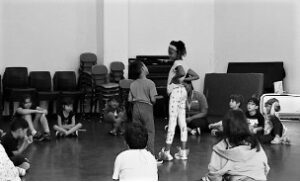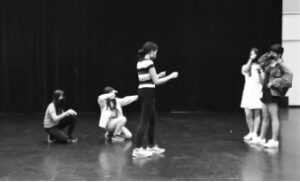Abigail Shabtay, PhD (York University)
ashabtay@yorku.ca
NEOS Issue 15, Volume 2, Fall 2023
Return to Current Issue Table of Contents
This article explores how embodied tableaux (a dramatic technique) can be used as a method in participatory research with children and youth. Methods discussed in this article were derived as part of the first phase of an ongoing, multi-year research program aimed at developing and adapting drama-based techniques as tools for participatory, child-centered research. Through this project, child and youth participants actively engaged with a range of drama-based approaches in order to explore and discuss topics that they found interesting and important to them. Child and youth participants then shared feedback on these methods to help identify best practices for using drama-based methods in child-centered research. The goal of the initiative is to take a child-centered approach to research methodology development, drawing on children’s perspectives, experiences, and opinions to help support the growth of best practices for the field.
This article focuses on methods adapted from a series of drama-based initiatives undertaken as part of this larger research program. These initiatives took place in Toronto, Canada, and involved a total of 54 child and youth participants between the ages of 4-17 years. Participants were recruited through digital posters and word-of-mouth and could voluntarily register to participate. All interested children and youth were able to participate, as long as the research team obtained assent (from minors) and consent (from parents/guardians, or from participants legally able to consent). Children and youth involved in these initiatives participated in either one-week or two-week programs (depending on age and availability) where they learned and engaged with a variety of drama-based methods and provided feedback on the methods through open-ended focus groups. As visual and embodied components are central to drama-based research, the team received consent and assent to video-record the programs, and to use photographs of participants in research articles and public dissemination.
Drama-Based Research and Tableaux
Drama-based research involves the use of theatrical activities and techniques to examine, explore, and disseminate research participants’ perspectives, thoughts, and experiences. Drama-based research approaches are qualitative methods, typically used to demonstrate participants’ unique ways of being and knowing and to provide researchers with a better understanding of participants’ experiences (Given 2008). There are a range of drama-based methods that can be used by researchers such as dramatic scene creation (Shabtay 2021a), verbatim theatre (Baer, Salisbury, and Goldstien 2019; Gallagher, Wessels, and Ntelioglou 2012), and playbuilding (Norris 2009; Shabtay 2021b), among others. As a professor and research methodologist in child and youth studies, one of my goals (and a key purpose for this article) is to expand researchers’ knowledge of drama-based methods, as the use of these approaches in social research (including anthropological research) with children is still gaining popularity.
One drama-based research approach, explored in this article, is the creation of embodied tableaux (often described as simply “tableaux”). In theatre and performance, the term ‘tableaux’ refers to the practice of performers creating still images using their faces and bodies. When using the tableaux method, embodied images are presented as frozen scenes in order to represent narratives, themes, emotions, experiences, and/or relationships (Branscombe and Schneider 2013; Mayor 2020). Tableaux may be created by individuals or in groups, and typically do not involve movement or dialogue, which makes this dramatic approach adaptable and accessible for a variety of child and youth participants (including those who are new to performance, those who face mobility challenges, or those who experience difficulty with verbal expression). Tableaux methods are also used in ‘image theatre’ practices developed by Boal (1995), as a form of interactive activist theatre with adults. While the tableaux method is widely used in theatrical productions, educational settings, and activist contexts, the use of these methods in child-centered research is still limited.
Using Embodied Tableaux in Research
Through explorations and conversations with child and youth participants, I have found that tableaux can be used as a child-centered research tool in a variety of ways. Some of the ways this method can be used include rapport-building, promoting child-led discussion, communicating feelings and experiences, and building comfort with other drama-based research methods.
Figure 1: Children playing the game ‘Come, all of my friends’
One tableaux-based activity that can be adapted and used in child-centered research is a participatory game called ‘Come, all of my friends’. In this game, children (and researchers) sit or stand together in a circle, all facing the middle of the circle. Children then take turns entering the middle of the circle and stating, ‘Come, all of my friends who…’ and share something about themselves to complete the statement (such as: ‘come, all of my friends who have siblings’ or ‘come, all of my friends who like playing video games’). Once a child has shared something, any other members of the circle who identify with the statement are invited to join the child in the centre of the circle (see Figure 1), and together they create a silent dramatic image representing the statement. As the children take turns sharing statements and creating tableaux images together, members of the group learn new things about each other. This activity can be useful in building rapport with child participants, as researchers are able to actively participate in the game by joining the circle and creating dramatic tableaux images, as Green (2012) notes “children respond positively to researchers who are … not afraid to sing songs and be silly” (283). This type of activity is also a unique way to engage children and youth in the research process, in that they exercise agency about what they would like to share with the group and learn about each other. This style of rapport-building activity is adapted from dramatic arts exercises used outside of the research space, such as in theatrical and educational settings, and can be further adapted for different settings (such as online video-based research) and to support participants with a variety of needs (Magni 2020).
Figure 2: Youth sharing their tableaux piece, titled ‘Beauty Standards’
In addition to helping build rapport with research participants, embodied tableaux can be used as a participatory research method where participants can explore, consolidate, and communicate their views, emotions, and experiences. This can be an entry point into a larger discussion of the themes showcased in their tableaux and the meanings behind the embodied images. For example, researchers can provide participants with open-ended prompts, such as ‘create an image about a social issue that is important to you’ and give participants time to reflect in groups and create a representational embodied image or series of images (see Figure 2). Participants can then present their tableaux and discuss the meanings behind their creations, and researchers can draw on these tableaux images to provoke further discussion about the topics and issues that participants presented. One 14-year-old participant shared, “The tableaux helped me better express my feelings because sometimes it’s harder for me to put things into words… like, it’s better if I can show what I feel, and then I’m able to explain and tell my story”.
Tableaux can be used to generate research data, both through what is displayed in the images themselves, and through participants’ explanations and follow-up discussions. The performances created by youth can also be presented to audiences as an ‘authentic’ form of dissemination where youth participants decide what they would like to showcase, as James (2007) notes, “We need to consider the ways in which children’s interests are represented [and] by whom their voices are represented” (262). These methods can be adapted for use in research projects on a range of topics, in a variety of contexts, and can be used in combination with other methods.
In addition to using tableaux as the only dramatic method in a project, tableaux activities can also be used as an entry point into more complex drama-based research methods such as dramatic scene creation (Shabtay, 2021a) or ethnodrama and playbuilding (Shabtay, 2021b). For research participants who are new to drama, tableaux can be less daunting than other techniques, since this method does not typically require speaking or movement. In my work, I often begin with tableaux-based warm-up activities to help participants build confidence using drama to communicate their views, before approaching other drama-based research methods. As one 11-year-old participant shared, “For me, tableaux games were so good because I used to be a bit shy about drama, but now after doing tableaux I realized actually it’s easy and fun and I’m not scared of doing other drama stuff”.
Concluding Thoughts
It is important that researchers continue to build on, adapt, and expand research methods to support the diverse range of interests and needs children and youth possess. Embodied tableaux methods, whether used on their own or in combination with other methods, offer excellent opportunities to build rapport with child and youth research participants and to learn about their ideas, views, feelings, and understandings. Incorporating participatory, arts-based, and child-centered techniques (such as drama-based research methods) can help strengthen communication with participants and contribute to a more well-rounded understanding of children and young people’s lived experiences.
Author Biography
Abigail Shabtay, PhD, is a professor in the Children, Childhood and Youth program at York University in Toronto, Canada. Dr. Shabtay’s research and teaching focus on child- and youth-centered research practices, children’s rights, and drama-based research. Dr. Shabtay is the Principal Investigator of several research projects focusing on children, youth, and the performing arts, funded by the Social Sciences and Humanities Research Council of Canada. She has received several awards for excellence in research and teaching in her field.
Funding Acknowledgement
This research was funded by the Social Sciences and Humanities Research Council of Canada.
References
Baer, Pamela, Jenny Salisbury, and Tara Goldstein. 2019. “Pairing Verbatim Theatre and Theatre of the Oppressed to Provoke Startling Empathy.” The Educational Forum 83 (4): 418–31.
Branscombe, Margaret, and Jenifer Jasinski Schneider. 2013. “Embodied Discourse: Using Tableau to Explore Preservice Teachers’ Reflections and Activist Stances.” Journal of Language and Literacy Education 9 (1): 95-113.
Boal, Augusto. 1995. The Rainbow of Desire: The Boal Method of Theatre and Therapy. New York, NY: Routledge.
Gallagher, Kathleen, Anne Wessels, and Burcu Wayman Ntelioglou. 2012. “Verbatim Theatre and Social Research: Turning Towards the Stories of Others.” Theatre Research in Canada 33 (1): 24–43.
Given, Lisa. 2008. The Sage Encyclopedia of Qualitative Research Methods. Thousand Oaks, CA: Sage Publications.
Green, Carie. 2012. “Listening to Children: Exploring Intuitive Strategies and Interactive Methods in a Study of Children’s Special Places.” International Journal of Early Childhood 44: 269-285.
James, Allison. 2007. “Giving Voice to Children’s Voices: Practices and Problems, Pitfalls and Potentials.” American Anthropologist 109 (2): 261-272.
Magni, Sarah. 2020. “Towards a Theatre of Neurodiversity: Virtual Theatre and Disability during a Global Pandemic.” MA diss. York University.
Mayor, Christine. 2020. “Embodied Tableaux: A Drama Method for Social Work Arts-Based Research.” Qualitative Social Work 19 (5-6): 1040–60.
Norris, Joe. 2009. Playbuilding as Qualitative Research: A Participatory Arts-Based Approach. Walnut Creek, CA: Left Coast Press.
Shabtay, Abigail. 2021a. “Dramatic Scene Creation as a Participatory Research Methodology with Youth.” Youth Theatre Journal 35 (1–2): 155–69.
———. 2021b. “Ethical Considerations in Drama-Based Research with Children and Young People.” In Ethics and Integrity in Research with Children and Young People, edited by Grace Spencer, 199–212. Bingley, UK: Emerald Publishing Limited.
Author contact: Abigail Shabtay, PhD (York University), ashabtay@yorku.ca
To cite this article: Shabtay, Abigail. 2023. “Using Embodied Tableaux as a Drama-Based Research Method with Children and Youth.” NEOS 15 (2).
To link this article: https://acyig.americananthro.org/neosvol15iss2fall23/Shabtay


